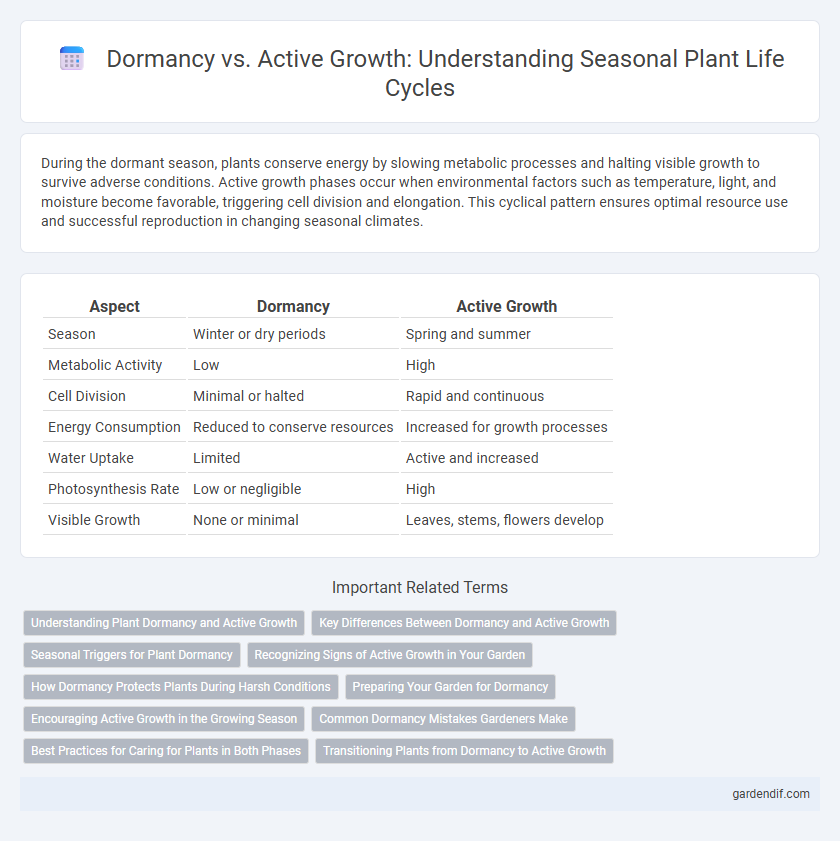
Dormancy vs Active growth Illustration
During the dormant season, plants conserve energy by slowing metabolic processes and halting visible growth to survive adverse conditions. Active growth phases occur when environmental factors such as temperature, light, and moisture become favorable, triggering cell division and elongation. This cyclical pattern ensures optimal resource use and successful reproduction in changing seasonal climates.
Table of Comparison
| Aspect | Dormancy | Active Growth |
|---|---|---|
| Season | Winter or dry periods | Spring and summer |
| Metabolic Activity | Low | High |
| Cell Division | Minimal or halted | Rapid and continuous |
| Energy Consumption | Reduced to conserve resources | Increased for growth processes |
| Water Uptake | Limited | Active and increased |
| Photosynthesis Rate | Low or negligible | High |
| Visible Growth | None or minimal | Leaves, stems, flowers develop |
Understanding Plant Dormancy and Active Growth
Plant dormancy is a survival strategy during unfavorable seasons, characterized by reduced metabolic activity and halted growth to conserve energy. Active growth resumes when environmental conditions such as temperature and daylight improve, triggering cellular processes like photosynthesis and nutrient uptake. Understanding the hormonal regulation, particularly the roles of abscisic acid in dormancy and gibberellins in promoting growth, is crucial for optimizing agricultural productivity and managing seasonal crop cycles.
Key Differences Between Dormancy and Active Growth
Dormancy is a survival strategy in plants where metabolic activity slows significantly, conserving energy during unfavorable conditions such as winter or drought. Active growth occurs when environmental factors like temperature, light, and water availability promote cellular division and elongation, leading to leaf development, flowering, and fruit production. The key difference lies in resource allocation; dormancy prioritizes maintenance and protection, while active growth channels energy into expansion and reproduction.
Seasonal Triggers for Plant Dormancy
Seasonal triggers such as decreasing daylight hours and lower temperatures initiate plant dormancy by signaling the end of the growing season. This shift causes metabolic slowdown and preparation for winter survival in many species. Identifying key environmental cues like photoperiod and temperature fluctuations is crucial for understanding dormancy patterns in temperate plants.
Recognizing Signs of Active Growth in Your Garden
During active growth, plants exhibit vibrant green leaves, new shoots, and increased bud formation, signaling a transition from dormancy. Soil temperature rises above 50degF (10degC), promoting root expansion and nutrient uptake essential for development. Regular monitoring of leaf size, stem elongation, and budding patterns helps gardeners optimize care and maximize plant health throughout the growing season.
How Dormancy Protects Plants During Harsh Conditions
Dormancy enables plants to conserve energy and resources by significantly slowing metabolic activities during harsh conditions such as winter or drought. This state minimizes water loss and cellular damage, enhancing survival rates through extreme temperatures or nutrient scarcity. By entering dormancy, plants protect vital tissues, ensuring they can resume active growth once favorable conditions return.
Preparing Your Garden for Dormancy
Preparing your garden for dormancy involves reducing watering, stopping fertilization, and pruning dead or diseased plants to conserve energy during the cold season. Mulching around perennials and shrubs protects roots from freezing temperatures and helps retain soil moisture. Clearing debris and fallen leaves minimizes pests and diseases, ensuring a healthy start for active growth in spring.
Encouraging Active Growth in the Growing Season
During the growing season, encouraging active growth involves optimizing sunlight exposure, maintaining consistent soil moisture, and providing balanced nutrients to support photosynthesis and cellular development. Implementing regular pruning stimulates new shoots and enhances air circulation, reducing disease risk while promoting vigorous plant expansion. Monitoring temperature and humidity levels ensures the environment remains conducive to metabolic processes essential for robust growth.
Common Dormancy Mistakes Gardeners Make
Many gardeners confuse dormancy with plant death, leading to premature pruning or watering that disrupts natural rest cycles. Ignoring chilling requirements delays bud break and reduces flowering potential, causing diminished plant vigor. Failing to protect dormant plants from extreme weather exposes them to damage, compromising overall growth in the active season.
Best Practices for Caring for Plants in Both Phases
During dormancy, watering should be minimal to prevent root rot while maintaining moderate humidity levels to support plant health. In the active growth phase, increase water and nutrient supply to encourage robust development, ensuring adequate sunlight and airflow to avoid fungal issues. Regularly monitoring soil moisture and adjusting care routines based on plant species ensures optimal growth and recovery in both dormant and active seasons.
Transitioning Plants from Dormancy to Active Growth
Plants transition from dormancy to active growth as environmental cues like increasing temperature and daylight trigger hormonal changes, particularly in auxins and gibberellins. This shift reactivates cellular metabolism and meristem activity, promoting bud break and leaf development. Understanding the precise timing and conditions for this transition is crucial for optimizing crop yield and garden plant health during seasonal changes.
Dormancy vs Active growth Infographic

 gardendif.com
gardendif.com